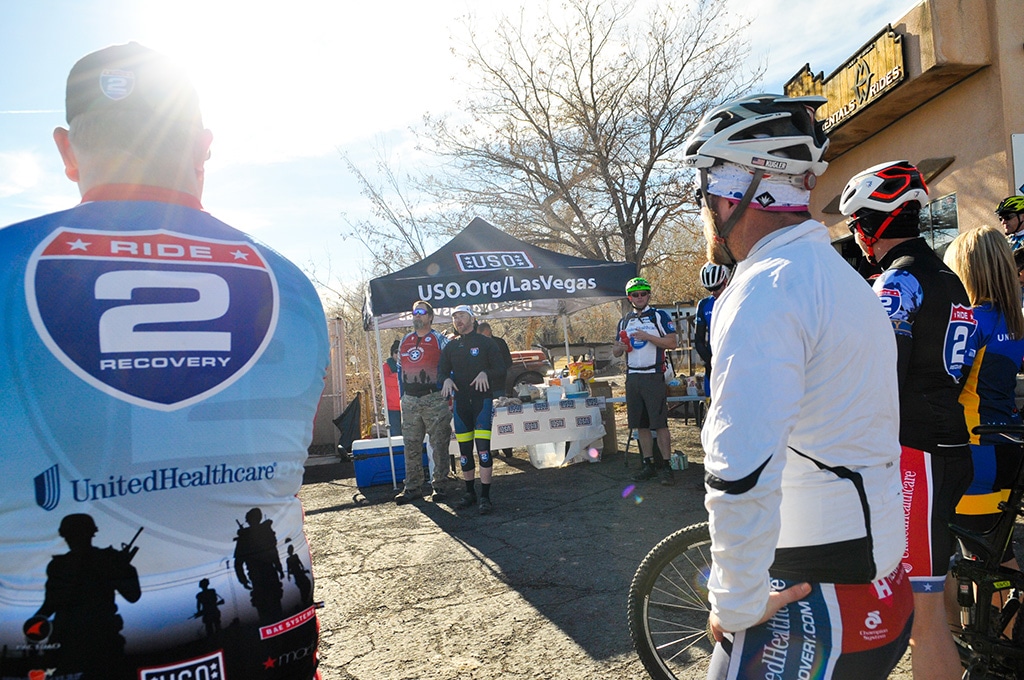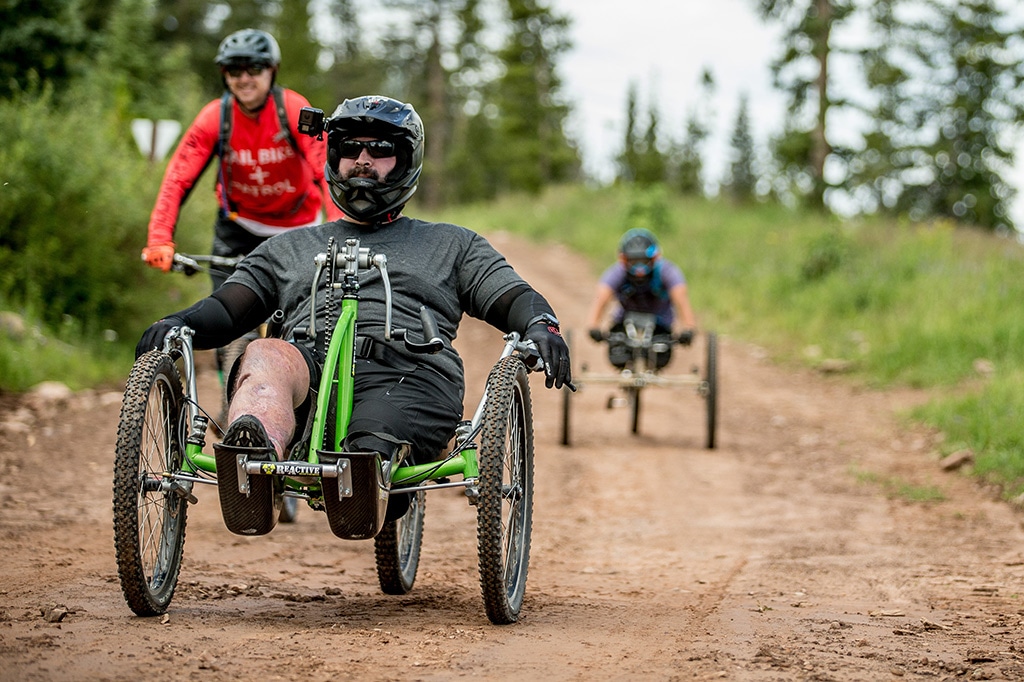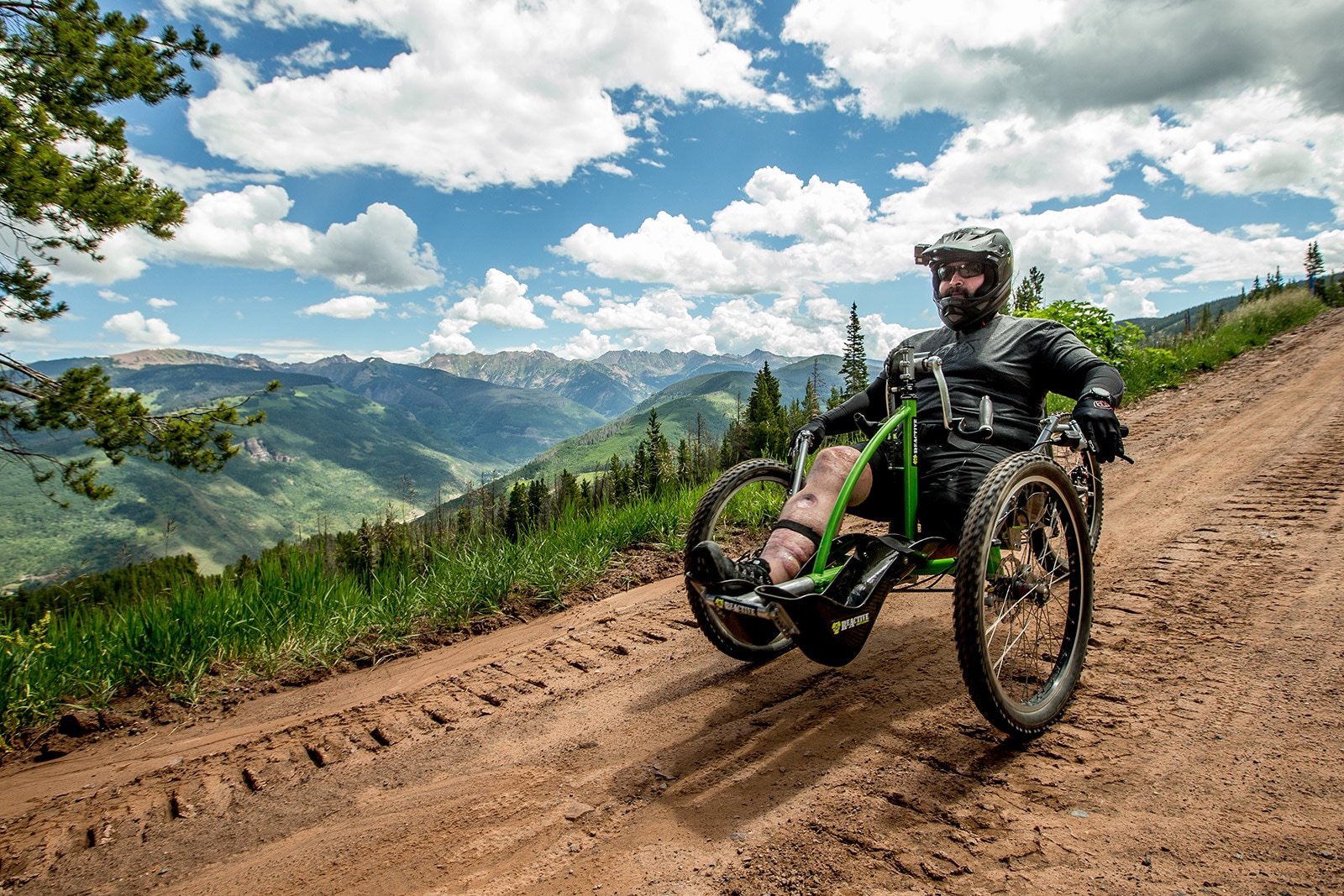For many members of our armed forces, returning home signifies the beginning of a different type of battle.
The laser focus that allows you to keep your tires tracking on the trail’s narrow tread. The playful challenge of picking your way through the rocks strewn on the trail. The hooting and hollering of buddies behind you. The sounds of nothing but nature. Hurtling downhill or huffing up. Most of the time, there’s something about a bike ride that feels healing, rejuvenating, calming, therapeutic. Rarely do we return home feeling worse than when we left.
That bike-joy is now being harnessed by some U.S. war veteran support groups. For some vets, the ride is what gets them to leave the house in the first place—and then allows them to put away the bike and carry on afterward.
“You’re always planning for the worst case scenario—someone getting killed or injured.”
Here’s the ugly truth: According to a 2012 Veterans Affairs (VA) report (download the PDF here), an average of 20 veterans take their lives every day. Needless to say, transitioning from combat to civilian life can be difficult, confusing and isolating for veterans—more so with the added burden of coming home with a debilitating physical or psychological injury.
“It’s a totally different environment over there,” said retired Marine Corps Master Sergeant Dean Zenoni. “There’s constant violence. You’re always planning for the worst case scenario—someone getting killed or injured. So when you come home from that, it’s really hard to readjust.”
Hence the haunting VA statistic. And while traditional medication management and behavioral health treatments can be effective for some veterans, such methods only scratch the surface for many others, like Zenoni. The treatment that worked best for him? Time in the saddle.
“When I got on the bike, it gave me hope.”
“I had been injured toward the end of my military career so there were a lot of activities I couldn’t do anymore,” he said. “Everyone knows that when you get injured, you can’t do anything, you put on weight, so that’s a hard road to come back from. When I found out about Ride 2 Recovery, it totally changed my life. My injury took away my career, it took away what I was good at, and when I got on the bike, it gave me hope.”
Ride 2 Recovery is one of the tenet programs of Project Hero, a national non-profit organization dedicated to helping veterans and first responders affected by Post Traumatic Stress Disorder (PTSD), Traumatic Brain Injury (TBI) and physical injury achieve rehabilitation, recovery and resilience in their daily lives. Cycling is in Project Hero’s DNA; the organization was founded in 2008, after a recreational therapist at a VA hospital in California approached John Wordin, an ex-professional cyclist and founder of the Fitness Challenge Foundation, wondering if cycling might be an effective therapy for PTSD and TBI.
According to Peter Bylsma, marketing director for Project Hero, Wordin knew that it was an idea worth exploring.
“It’s the physical activity and discipline that are an integral part of cycling that make it unique in its ability to make it a positive rehabilitation activity,” he said. “There’s something special about riding a bike. It may not have been invented for this purpose, but it’s well suited for it.”
Challenge Rides, multi-day point-to-point rides organized by Project Hero that are solely for injured veterans and active military, are illustrative of the benefits that can come from putting veterans on bikes, together. Feedback from participants almost always includes the following: I can talk to people on the ride about things that no one else understands.
“It’s transcendent,” said Bylsma. “The combination of being on the bike—the physical—with the mental aspect that the veterans are riding with people they trust.”

Ride 2 Recovery at Red Rock Canyon in Las Vegas, Nevada | Photo: Project Hero
And most cyclists would likely agree that the healing qualities associated with riding extend past the simple act of pushing pedals; the sense of community among riders fosters wellness, too. Christopher Richardson, the acting Marketing Director for Pedal Against PTSD, another non-profit seeking to help veterans through cycling, has found that the biking community as a whole has helped lay the groundwork for the organizations’ ability to reach veterans.
“Whether you live in a small town or a big city, there are like-minded people doing rides,” he said. “And that’s an additional layer of support.”
Pedal Against PTSD was born after Kevin Campagna, a U.S. Marine Corps combat veteran, completed the 2013 Tour Divide (a 2,745-mile, self-supported race that roughly follows the Continental Divide from Canada to Mexico) and felt inspired to share his passion for cycling as a source of relief for his affliction with PTSD. The organization’s mission is threefold: to provide veterans with bicycles, create a strong community outreach program, and contribute to the research and development of PTSD treatment. Richardson feels strongly that the bicycle can be an alternative to medication-driven therapy.
“Exercise is a stress reliever, and too much stress can trigger episodes of PTSD,” he said. “We want to empower vets in a non-medication driven way, and exercise is extremely therapeutic.”
Increasingly, researchers are linking exercise to better mental health.
Fortunately, the VA seems to be taking note that a different approach to addressing veteran rehabilitation is necessary. In a July 2017 interview, VA Secretary David Shulkin pledged to look beyond traditional forms of treatment.
“This is an unacceptable statistic that 20 veterans a day are taking their life to suicide,” said Shulkin. “So we are going to do everything that we possibly can. We’re reaching out to community groups, to academic groups. We’re doing research in this area. We’re trying new therapies and treatments. And I certainly hope that we can have a big impact on this problem.”
And the VA has more to go on than horrifying statistics—increasingly, researchers are linking exercise to better mental health. A 2010 study from the American College of Sports Medicine showed that just one 30-minute exercise session can boost your mood and help tackle depression, both of which are frequent effects of PTSD and TBI. Programs that use bikes as therapy for vets can count on these neurochemical benefits, but the rehabilitative gains don’t stop there.
Perhaps the power of riding bikes for rehabilitation is that it produces a trifecta of effects: physical stimulation, psychological regulation and a sense of security and solidarity. A veteran may start riding as a way to address a physical injury and find that it’s the invisible injury being treated. Another may pick up a bike to escape and be alone only to learn that pedaling alongside an old friend is what she actually needed.
“I mean that it’s good for the soul, you know? Just feeling the wind in your face and the rush of pinning a tight corner.”
Cheryl Jensen, founder and executive director of Vail Veterans, an organization nearing its 15th year of supporting veterans through a variety of programs, has found that some veterans want to experience the therapeutic outdoors with their families and that families of veterans also benefit from meeting each other and sharing their experiences. The Colorado organization works with three military hospitals to bring patients directly from the hospital or outpatient setting to the central Rocky Mountains.
“The variety in our programming is to meet their needs, it’s not for us,” said Jensen. “Our family programs have evolved because of this.”
When it started, Vail Veterans only offered winter sports to vets and their families. “But one veteran didn’t like the snow and cold,” said Jensen, “so we decided to add summer programs.” When Vail Veterans added mountain biking to its menu of activities in 2012, Jensen found that it married nicely into the existing format. “It’s like skiing,” she said, “You give someone a gravity sport, and they don’t feel their injury.”

Miller and another participant descend a trail during a Vail Veterans Program. Photo courtesy of Vail Veterans
Take retired U.S. Navy SEAL and Vail Veterans participant, Elliott Miller. The scope of his injuries is almost inconceivable: an above-the-knee amputation, an anoxic brain injury that has rendered him unable to speak, heterotrophic ossification (basically, where bone grows in soft tissue where bone should not exist), and burns covering 35% of his body. Miller and his wife April have traveled to Colorado twice to participate in downhill mountain biking with Vail Veterans.
“I’m no doctor,” Miller wrote me in an email, “but if I was I would probably say that any physical activity is good for rehabilitation. Especially when you can combine it with something that is a bit of an adrenaline rush. I mean that it’s good for the soul, you know? Just feeling the wind in your face and the rush of pinning a tight corner—there’s nothing like it.”
